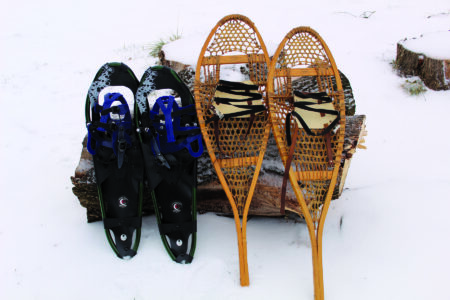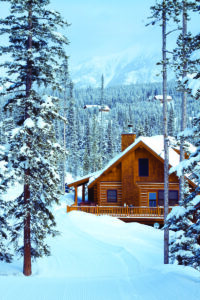Folks say spring is right around the corner in March in my neck of the northeastern United States, but you’d be hard-pressed to prove it to me. Around here, winter can last well into April. You just have to go with it.
The pellet stove will keep our home at a comfortable 70 degrees Fahrenheit, but in late winter, the pellet stores can get pretty low. Heat isn’t my only concern, though. My food supply gets low around this time of year as well. I know my family won’t starve and we’ll have enough to last another month or so, but we’ll be cutting it pretty close. The once-stocked freezer often looks a tad bare as I pull a couple of trout out for dinner in March.
There’s good news in all of this. Despite long and cold winters, my family survives. The days get longer and the sun gets higher in the sky every day. Any storms are just minor setbacks, bumps in the road to the warmer weather that’s sure to come. Over the years, I’ve been asked, “How can you live in those conditions?” My answer is that if you live out in the country, you have to prepare for anything that may come your way.
Winter is one of those things we can’t control. Surviving winter is all about being prepared, and not about last-minute thoughts as a storm is bearing down on you. If you don’t have your act together when the first arctic blast arrives, or when the first snowflakes fall, then it may already be too late. For me, the preparation process begins the previous spring, long before the last snow disappears.

Keep Good Records
I learned a long time ago that it’s very hard to keep track of every little detail in my head, no matter how hard I try. So, I started compiling the data I needed to remember in a notebook. I recorded the things I did right and wrong each year, such as the number of tons of wood pellets I went through, the number of gallons of fuel I used, how much food we ate, and the length of each winter. By looking back over this data, I can observe trends to help me predict what I’ll need for the upcoming year.
For example, two years ago, I used 2 tons of pellets to heat my home. The next year, I used 2-1/2 tons, but last year, 2-1/2 tons barely made it through. Armed with this information, my plan for future winters is to have 3 tons of pellets on hand.
Food is another thing to plan for. My records indicate that my family needs about 20 pounds of fish and 100 pounds of red meat to see us through winter. One good-sized deer, supplemented by a couple of turkeys, a few grouse and waterfowl, and small game, is usually enough. But hunting and fishing for food is a hit-or-miss enterprise. You can’t count on getting a deer every year, so you have to have a backup plan. Thankfully, I know some people who raise grass-fed and grass-finished cattle and other livestock. I usually purchase about 30 pounds of meat from them as an insurance policy. When I can, and if it’s legal to do so, I also head into the winter woods and look for small game. If I can bring home a rabbit, a few squirrels, or even a porcupine, that’s one or two meals covered without us dipping into the freezer.

Year-Round Preparation
Come March, I begin inspecting our buildings for winter damage. Late winter is a good time to do this, because fishing season hasn’t started and it’s too early to begin working the soil for the garden. It’s very important to keep your shelter and supporting buildings in top condition. If you find problems, fix them as soon as possible.
I also start seeds indoors for tomatoes, squash, and the like in anticipation of spring planting. The growing season is relatively short in the Northeast, and this practice gives me an extra week or so of productive growing. I’ll sow the seeds of cold-weather crops, such as peas and lettuce, directly in the ground as soon as I can work the soil.
When April arrives, I’m out fishing. My thoughts turn to the never-ending task of feeding my family and filling our freezer. Fish help fill the void in our freezer and feed us throughout the year. Full-fledged foraging also begins in April and May when the first berries emerge. I’ll continue to forage throughout the year.

Harvesting from the garden takes place throughout summer, but September is when I spend a great deal of time picking and preserving vegetables. Apples grow wild here, so we preserve them as applesauce. We smoke some of the fish, and I begin to hunt game as different animals come into season.
September is when I load up on pellets for the stove. They’re plentiful and less expensive than when the snow begins to fall. I also do maintenance on my generator and other machinery, and purchase the fuel I’ll need for them.
In October and November, I hunt in earnest. That’s the start of winter in the Northeast, despite what the calendar may say. Snow and cold aren’t uncommon, and my time in the woods needs to be productive. A deer or a bear will go a long way toward fulfilling my family’s needs. Winter is also a good time to forage for nuts.
By the end of November and the beginning of December, the air is so cold that it hurts to breathe, and I’m battening down the hatches: one last check on the generator, pellets, and fuel; and perhaps one more hunt for small game. I check and double-check our food supply, making sure that we have plenty of canned goods in addition to what’s in the freezer. I pull out other winter essentials, such as my emergency radio and portable solar panels.

Dress for Success
No matter what the conditions, you’ll occasionally have to go outside in winter. You may be out for a few hours or a couple of minutes, but no matter how long, you need to stay warm.
Dress in layers rather than in one heavy coat. As you warm up while you work, you can shed layers, and as you cool down, you can put them back on. Many manufacturers make cold-weather clothing, some using natural materials and some synthetic. Both can be effective. I happen to like natural fibers, such as wool, near my skin. I reserve synthetics for outer layers, because synthetic material tends to shed snow and freezing rain better. Wool is great because it wicks moisture away from your skin, and wet skin will lower your body’s core temperature, which can cause hypothermia over extended periods. Wear a hat that covers your ears, and, whenever possible, protect your hands with mittens rather than gloves. As for my feet, I wear waterproof, insulated boots and wool socks.

Don’t Neglect Your Mind
Mentally, winter is the hardest time of year. Long hours of darkness combined with being cooped up in the house for extended periods of time will take their toll on you. The trick is to stay busy.
On days when I need to stay indoors, I do maintenance on my gear and tools. This is also a great time to sew clothes or knit hats and mittens. I’ll grab a cup of coffee and sit by the pellet stove to clean my firearms and fishing gear or sharpen knives. I may catch up on some reading or even write an article or two, as I always seem to have looming deadlines. When I can get out, I’ll put on snowshoes and hunt for small game. Or, I may go out and do some scouting to prepare for next year. Whatever you do, find something to keep both your body and your mind active until spring.
Winter Readiness Checklist
- Fuel: What kinds of fuel do you need for heat and electricity? Do you have enough to outlast any outages or periods during which you won’t be able to fetch more?
- Food: How much food does your household need? Do you have a variety of foods to provide balanced nutrition? Do you have a backup plan in case your food storage system fails, or you’re unable to cook raw foods?
- Clothing: Do you have appropriate gear for being out in the elements? Do you know how to layer up and cover vulnerable areas, such as your hands, feet, and face? Is all your gear in good condition?
- Entertainment: How will you fill periods of time when you can’t leave your house or homestead? Which tasks or hobbies provide mental stimulation? Do you have options that don’t require electricity?
Dana Benner has been writing about the outdoors and rural life for more than 30 years, and believes preparation is the key to success as an outdoorsperson and homesteader.








